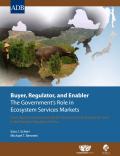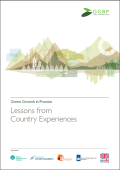
This paper firstly reviews the emerging literature on green growth, with a focus on the origin and meaning of the concept, as well as the justifications for and criticisms of the concept. The general idea of taking into account the impact of economic growth policies on the environment is not very controversial, but the possibility of simultaneously achieving conventional GDP growth and environmental protection is debated. It then discusses how China might move on to a green growth path. It summarizes a sizable literature that traces China’s rapid economic growth and the associated environmental problems to its unique and fundamental institutions, and discuss the implications of this on how China might grow more sustainably.
This report investigates how cities can use different instruments to integrate the environment into urban planning and management approaches. Including: policy instruments, process instruments, planning instruments and management instruments. The report examines how these instruments are applied to several well established approaches to integrated urban planning. It examines the characteristics, strengths and weaknesses of Integrated Development Plans, City Development Strategies, ecoCity Planning, ecoBUDGET and Strategic Environmental Assessment.
The report also includes 12 case studies of cities that have worked to integrate the environment into their planning processes including: Egypt (Alexandria), Thailand (Bangkok), Republic of Cuba (Bayamo), the Philippines (Bohol), Bulgaria (Bourgas), Canada (Calgary), South Africa (Cape Town), Brazil (Goiânia; Porto Alegre), Columbia (Manizales), Kenya (Nakuru), and the People’s Republic of China (Yangzhou).

Green growth is becoming an attractive opportunity for countries around the world to achieve poverty reduction, environmental protection, resource efficiency and economic growth in an integrated way. Green growth strategies generate policies and programs that deliver these goals simultaneously. They accelerate investment in resource efficient technologies and new industries, while managing costs and risks to domestic taxpayers, businesses, communities and consumers.
This report carried out by the Green Growth Best Practice (GGBP) initiative, is the first comprehensive international assessment of lessons from experiences of pursuing green growth across all levels of government and all regions. The report is the result of a collaborative partnership between the Climate & Development Knowledge Network (CDKN), the European Climate Foundation (ECF) and the Global Green Growth Institute (GGGI). It engaged 75 authors in evaluating more than 60 programs around the world.

This report describes efforts by the ClimateWorks Foundation and the World Bank to quantify the multiple economic, social, and environmental benefits associated with policies and projects to reduce emissions in select sectors and regions.
The report has three objectives: 1) to develop a holistic, adaptable framework to capture and measure the multiple benefits of reducing emissions of several pollutants; 2) to demonstrate how local and national policymakers, members of the international development community, and others can use this framework to design and analyze policies and projects; and 3) to contribute a compelling rationale for effectively combining climate action with sustainable development and green growth worldwide.
